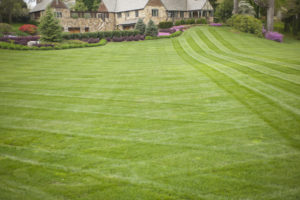
There are three main ways that plants, including turf grasses, propagate. Some spread by flowering and producing seeds, which are then carried off (by wind, water, or critter) to other areas to germinate.
If you hope and dream of a thick, lush lawn without any bare spots, you are probably learning about perennial lawn grasses. These grasses are bred to spread and fill in bare spots, but what happens when you get too much of that spreading? How do you keep the grass contained where you want it – your lawn – and out of the areas that you don’t – your garden beds, walkway gaps, and so on? The trick is a good, solid edge to your lawn and a clear divide between grass and non-grass areas. Read on for tips to guide the growth of your grass to achieve lawn harmony.
Understand Propagation
There are three main ways that plants, including turf grasses, propagate. Some spread by flowering and producing seeds, which are then carried off (by wind, water, or critter) to other areas to germinate. Some are spread by rhizomes, roots that shoot runners under the soil, and those grow upwards into more grass. Finally, some are applied by stolons, which are surface runners that reach out from the plant and then take root and grow down.
Hand Weeding
Hand weeding is the best way to stop flowering grasses and stolons and remove them from your garden beds. It’s also the most responsible way to stop rhizomes, but it is very labor-intensive. With rhizomes, simply pulling the grasses up doesn’t stop the problem – you have to dig down to the root.
Weed Killers
Herbicides and torch weed killers can be more practical tools for weed control than hand weeding, but you risk hurting other plants. A broad-spectrum herbicide will kill any plant it lands on, even if it is just blown around on a breezy day. The garden torch is a little more controlled in its application, but it can also be a hazard if you are not careful.
Edging Blocks
Garden edging can be a solution to stopping grass spread that you don’t want, but it has to be very deep, very tall, and impenetrable. Plastic and metal are your best bets for edging to control grass. Bricks will eventually allow rhizomes through, and wood will rot pretty quickly under the dirt. If you do go with edging, make sure that it is at least a foot deep.
Bunchgrasses
Finally, if spreading grasses are an issue, it may just be that spreading grasses don’t meet your needs. Consider swapping out with bunchgrasses instead. Perennial ryegrass and fine fescues, for example, don’t propagate by either rhizomes or stolons, so they tend to stay in the place that you plant them.
Have More Questions? Stay in Touch!
Order early and order often to ensure the best service possible. Contact us through our online page. Please find us at 27616 Little Lane, Salisbury, Maryland 21801. Our phone number is 410-726-6103, and our fax number is 410-742-6550. Speak to Jason Anderson for Turf Grass Sales. Reach him by email at jason@quanticocreeksod.com. Finally, follow us on social media on Facebook, LinkedIn, and our blog!
